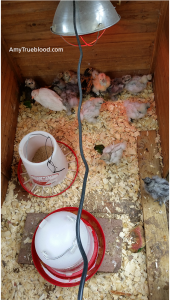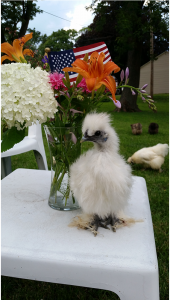The chicks that my cousin hatched out for us 3 weeks ago are getting much larger now. They really needed to get out of the brooder and into their own full size chicken coop. I really liked the first chicken coop that we have and wanted to build the second one the same way. It’s a solid design that has kept out predators for us plus it was cheap to make and quick too. It took 3 people about 12 hours to build the run for this coop, with multiple trips to the hardware store. The total cost for the house/coop and the run was $247.47.

What you’ll need to buy:
| Material | Quantity | Unit Price | Total |
| Pre-Built Dog House | 1 | $109.99 | $109.99 |
| 2″x2″x36″ Baluster (used for porch railing) | 23 | $0.89 | $20.47 |
| Hardware cloth (3′x10′; 36″ wide with 1/4 inch holes) | 4 | $17.97 | $71.88 |
| Door Hinges (3″) | 2 | $2.49 | $4.98 |
| Safety Latch (make sure it isn’t more than 3″ wide) | 1 | $2.98 | $2.98 |
| Door Handle (4″) | 1 | $2.60 | $2.60 |
| Rubber Coated Cup Hooks | 1 | $0.99 | $0.99 |
| 9×3 Outdoor Wood Screws | 1 | $7.99 | $7.99 |
| Staples (T50 3/8″) | 1 | $3.46 | $3.46 |
| Sand paper (60/100/120 grit) | 1 | $2.29 | $2.29 |
| Play Sand | 8 | $2.48 | $19.84 |
| Grand Total | $247.47 |
Tools you’ll need:
Drill
1/8″ Drill Bits
Phillips Screwdriver Bit
Hammer
Mallet
Wood Hand Saw
Metal Hand Saw
Staple Gun
Pliers
Straight Cut Aviation Metal/Tin Snips/Shears
Clamps
2″x4″ Wood
Tape Measure
Pencil
Chicken Coop Supplies:
Extension Cord
Heat Lamp
Feeder
Waterer
Landscape Brick
Chicken Coop Instructions
- Put together the pre-built dog house/chicken coop per the manufacturer’s instructions except you shouldn’t screw on the roof. We’ve left it unscrewed for easy access into the coop.
- Cut off both of the angled ends of 15 Balusters using the clamps to hold the wood in place on your work surface (I used a stool) and the wood hand saw. Get as close to the edge as possible so the are square, but it doesn’t need to be perfect. Use the sandpaper to finish the ends so you don’t get any splinters later on.
- Cut off one angled end of 8 Balusters. These will be used for the chicken coop sides. Use the sandpaper to finish the ends so you don’t get any splinters later on.
- Screw together your top and bottom. I used the 1/8″ drill bit to pre-drill the holes. The outdoor wood screws have a feature on the end that makes them easier to install, but I still find it easier to pre-drill the holes. If any screws pop through when doing the middle pieces, use the metal hand saw to cut off the screws.


- Roll out the hardware cloth over the top piece. We used landscape bricks to hold down the hardware cloth before cutting it. Cut to size with tin snips. You should only have to cut one end as it is already the the same size as the 36″ Balusters. Try to cut as close to the joints as possible to avoid snagging your clothing later on. Secure the hardware cloth to the wood with staples every 3″. If you miss or the staple doesn’t go in all the way, use the pliers to pull it out or the hammer to push it in.
- Repeat step 4 for the bottom piece.
- Now you’re ready to secure the top to the bottom. Screw in the side pieces to the bottom. There is a Baluster at each corner, and two in the middle to stabilize the chicken coop.
- Screw in the side pieces from the top so it is screwed on bottom and top.
- Add your hardware cloth to both sides.

- For the ends, you’ll start with the part of the run that the chicken coop goes into. We used 2″x4″ pieces of wood around the front of the door to make sure the chickens had a secure entrance. The only hardware cloth we used on the opening was just at the top. There is a 5″ gap between the coop roof and the run. Screw in a 36″ baluster with both ends cut off, trim the hardware cloth and staple it. Use the mallet to get the Baluster into place if it is a snug fit.

- For the door, screw together your door and add on your hardware cloth. Use a pencil to mark where the holes for your hinges will go and screw the door to the coop. On our new coop, I put the hinge flat onto the door and supporting side piece. For the first coop, I put it on a right angle. Screw on your handle and latch. We use a combination lock to lock the door of the coop since we live in the city.

- Next to the door, you’ll want to add in your last Baluster piece so you can close the coop with hardware cloth.
- Screw in a cup hook on either side of the coop, just below the roof. You’ll use these to hang a heat lamp on one side and your feeder on the other.

- Add in bedding. We use sand in the run and corn cob or pine shaving bedding for the coop.
- Add in your waterer, use a landscape brick to keep the chickens from getting a lot of bedding in it.
- Add in your chicks/chickens and get the camera out!


Optional Accessories:
Porch Swing Bird Feeder-I just fell in love with this feeder and since it is the end of the season, I happened to get one on closeout at Lowe’s. I’ve also seen this at Tractor Supply Company too.
Flowers/Herbs-I got a few pots of pollinator-friendly flowers to put around our honeybee hives and the coops. There are herbs that people plant near their chicken coops to reduce odor and bugs. I’d like to plant basil, lavender, mint and rosemary next year.
Exercise Pen with Bird Net-During the summer I wanted to let the chickens have a little extra room without sacrificing safety. A fellow BYC Indiana thread commenter, recommended this great exercise pen. I found it at Tractor Supply and just added chicken wire on the outside with zip ties to secure it. I put bird netting above it to keep out any flying predators. The chickens are closed up at night and only allowed outside in the extra space during the day.
Chicken Roost-I bought a thick dowel rod and used closet hardware to add a roost on the inside of our first coop. The closet hardware lets you take the rod out to clean it easily. You can see a chicken on the roost in the photo above.
PVC Waterer-My cousin actually custom built a waterer out of PVC and nipples for our first coop. It holds 2 gallons of water and works really well.
Rocks/Driftwood-I added in some different sized rocks and a piece of driftwood to our first coop so the chickens could perch and give them something to do. When the coop is cleaned out, I re-arrange them to make it more interesting for them.








